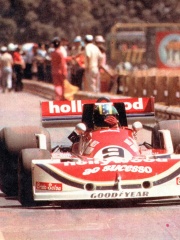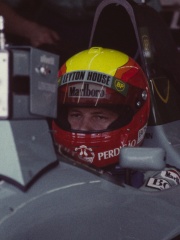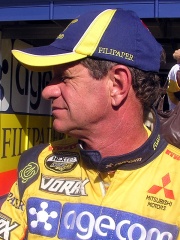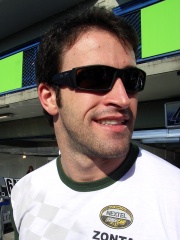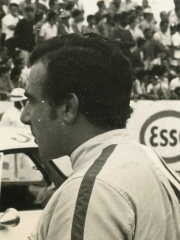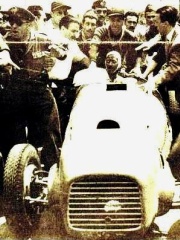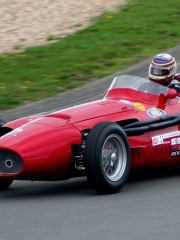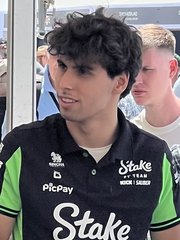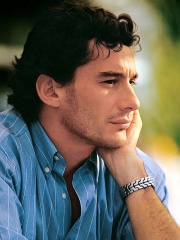
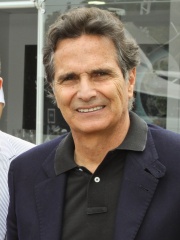
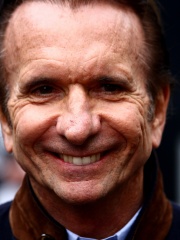
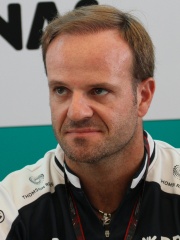
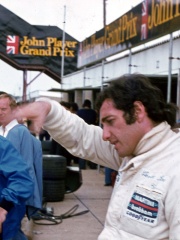
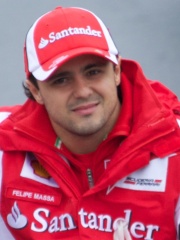

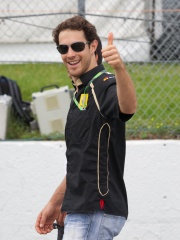
The Most Famous
RACING DRIVERS from Brazil
This page contains a list of the greatest Brazilian Racing Drivers. The pantheon dataset contains 1,080 Racing Drivers, 33 of which were born in Brazil. This makes Brazil the birth place of the 8th most number of Racing Drivers behind Spain, and Japan.
Top 10
The following people are considered by Pantheon to be the top 10 most legendary Brazilian Racing Drivers of all time. This list of famous Brazilian Racing Drivers is sorted by HPI (Historical Popularity Index), a metric that aggregates information on a biography's online popularity. Visit the rankings page to view the entire list of Brazilian Racing Drivers.

1. Ayrton Senna (1960 - 1994)
With an HPI of 82.72, Ayrton Senna is the most famous Brazilian Racing Driver. His biography has been translated into 90 different languages on wikipedia.
Ayrton Senna da Silva (Brazilian Portuguese: [aˈiʁtõ ˈsẽnɐ dɐ ˈsiwvɐ] ; 21 March 1960 – 1 May 1994) was a Brazilian racing driver who competed in Formula One from 1984 to 1994. Senna won three Formula One World Drivers' Championship titles with McLaren, and—at the time of his death—held the record for most pole positions (65), among others; he won 41 Grands Prix across 11 seasons. Born and raised in São Paulo, Senna began competitive kart racing aged 13; his first go-kart was built by his father using a lawnmower engine. After twice finishing runner-up at the Karting World Championship, Senna progressed to Formula Ford in 1981, dominating the British and European championships in his debut seasons. He then won the 1983 British Formula Three Championship amidst a close title battle with Martin Brundle, further winning the Macau Grand Prix that year. Senna signed for Toleman in 1984, making his Formula One debut at the Brazilian Grand Prix. After scoring several podium finishes in his rookie season, Senna moved to Lotus in 1985 to replace Nigel Mansell, taking his maiden pole position and victory at the rain-affected Portuguese Grand Prix, a feat he repeated in Belgium. He remained at Lotus for his 1986 and 1987 campaigns, scoring multiple wins in each and finishing third in the latter World Drivers' Championship. Senna signed for McLaren in 1988 to partner Alain Prost; together, they won 15 of 16 Grands Prix held that season—driving the Honda-powered MP4/4—with Senna taking his maiden championship by three points after winning a then-record eight Grands Prix. Their fierce rivalry culminated in title-deciding collisions at Suzuka in 1989 and 1990, despite Prost's move to Ferrari in the latter, with Prost winning the former title and Senna taking the following. Senna took seven victories, including his home Grand Prix in Brazil, as he secured his third title in 1991. The dominant Williams–Renault combination prevailed throughout his remaining two seasons at McLaren, with Senna achieving several race wins in each, including his record-breaking sixth Monaco Grand Prix victory in 1993 on his way to again finishing runner-up to Prost in the championship. Senna negotiated a move to Williams for his 1994 campaign, replacing the retired Prost to partner Damon Hill. During the 1994 San Marino Grand Prix at Imola, Senna was killed in a crash whilst leading the race, driving the Williams FW16. His state funeral was attended by over a million people. Following subsequent safety reforms, he was the last fatality in the Formula One World Championship until Jules Bianchi in 2015. Senna achieved 41 wins, 65 pole positions, 19 fastest laps and 80 podiums in Formula One; he remains a legendary figure within motorsport for his raw speed and uncompromising driving style, as well as his philanthropy, and is frequently cited as a national hero of Brazil. He was also widely acclaimed for his wet-weather performances, such as at the 1984 Monaco, 1985 Portuguese and 1993 European Grands Prix. Senna was inducted into the International Motorsports Hall of Fame in 2000.

2. Nelson Piquet (b. 1952)
With an HPI of 74.83, Nelson Piquet is the 2nd most famous Brazilian Racing Driver. His biography has been translated into 55 different languages.
Nelson Piquet Souto Maior (Brazilian Portuguese pronunciation: [ˈnɛwsõ piˈke], born 17 August 1952) is a Brazilian former racing driver and businessman, who competed in Formula One from 1978 to 1991. Piquet won three Formula One World Drivers' Championship titles, which he won in 1981, 1983, and 1987, and won 23 Grands Prix across 14 seasons. Piquet had a brief career in tennis before losing interest in the sport and subsequently took up karting and hid his identity to prevent his father discovering his hobby. He became the Brazilian national karting champion in 1971–72 and won the Formula Vee Brazil championship in 1976. With advice from Emerson Fittipaldi, Piquet went to Europe to further success by taking the record number of wins in Formula Three in 1978, beating Jackie Stewart's all-time record. In the same year, Piquet made his Formula One debut with the Ensign team and drove for McLaren and Brabham. In 1979, he moved to the Brabham team and finished the runner-up in 1980 before winning the championship in 1981. Piquet in 1982 was hampered by severe engine unreliability, but he saw a resurgence for 1983 and his second world championship. For 1984–85, Piquet had once again lost chances to win the championship but managed to score three wins during that period. He moved to the Williams team in 1986 and was a title contender until the final round in Australia. Piquet took his third and final championship in 1987 during a heated battle with teammate Nigel Mansell which left the pair's relationship sour. Piquet subsequently moved to Lotus for 1988–89 where he experienced his third drop in form. He eventually went to the Benetton team for 1990–91 where he managed to win three races before retiring. After retiring from Formula One, Piquet tried his hand at the Indianapolis 500 for two years. He also had a go at sports car racing at various points during and after his Formula One career. Piquet is currently retired and runs several businesses in Brazil. Piquet has faced several controversies since the 1980s—predominantly for his use of homophobic language—and was banned from the Formula One paddock in 2022. The ban was lifted in 2024.

3. Emerson Fittipaldi (b. 1946)
With an HPI of 74.29, Emerson Fittipaldi is the 3rd most famous Brazilian Racing Driver. His biography has been translated into 49 different languages.
Emerson Fittipaldi (Brazilian Portuguese: [ˈɛmeʁsõ fitʃiˈpawdʒi]; born 12 December 1946) is a Brazilian former racing driver and motorsport executive, who competed in Formula One from 1970 to 1980. Fittipaldi won two Formula One World Drivers' Championship titles, which he won in 1972 and 1974 with Lotus and McLaren, respectively; he won 14 Grands Prix across 11 seasons. In American open-wheel racing, Fittipaldi won the IndyCar World Series in 1989 with Patrick, and is a two-time winner of the Indianapolis 500. Moving up from Formula Two, Fittipaldi made his race debut for Team Lotus as a third driver at the 1970 British Grand Prix. After Jochen Rindt was killed at the 1970 Italian Grand Prix, the Brazilian became Lotus's lead driver in only his fifth Grand Prix. He enjoyed considerable success with Lotus, winning the World Drivers' Championship in 1972 at the age of 25. At the time, he was the youngest ever F1 world champion, and he held the record for 33 years. He later moved to McLaren for 1974, winning the title once again, and helping McLaren win their first Constructors' Championship. He surprised the paddock by moving to his brother's Fittipaldi Automotive team prior to the 1976 season, being replaced by James Hunt. Success eluded him during his final years in Formula One, with the Fittipaldi cars not competitive enough to fight for victories. Fittipaldi took two more podium finishes, before retiring in 1980. Following his Formula One career, Fittipaldi moved to the American CART series, achieving numerous successes, including the 1989 CART title and two wins at the Indianapolis 500 in 1989 and 1993. Since his retirement from Indy Car racing in 1996, Fittipaldi races only occasionally. In 2008, he became one of only three people in history to have a Corvette production car named in his honor. At age 67, he entered the 2014 6 Hours of São Paulo.

4. Rubens Barrichello (b. 1972)
With an HPI of 67.51, Rubens Barrichello is the 4th most famous Brazilian Racing Driver. His biography has been translated into 57 different languages.
Rubens Gonçalves Barrichello (Brazilian Portuguese: [ˈʁubẽjz ɡõˈsawviz baʁiˈkɛlu]; born 23 May 1972) is a Brazilian racing driver and broadcaster, who competes in the Stock Car Pro Series for Full Time Sports. Nicknamed "Rubinho" (pronounced [ʁuˈbĩɲu]), Barrichello competed in Formula One from 1993 to 2011, and twice finished runner-up in the World Drivers' Championship in 2002 and 2004 with Ferrari; he won eleven Grands Prix across nineteen seasons. In stock car racing, Barrichello is a two-time champion of the Stock Car Pro Series in 2014 and 2022 with Full Time Sports. Born and raised in São Paulo, Barrichello started his career in karting, winning several national titles before progressing to junior formulae in 1989. Barrichello moved to Europe the following year, winning his first title at the Formula Opel Lotus Euroseries before his victory at the 1991 British Formula Three Championship with West Surrey. He progressed to International F3000 in 1992, finishing third in his rookie season. Barrichello signed for Jordan in 1993, making his Formula One debut at the South African Grand Prix. He retained his seat for 1994, achieving his maiden podium at the Pacific Grand Prix and qualifying on pole for the Belgian Grand Prix as he finished sixth in the World Drivers' Championship. After two further seasons with Jordan—scoring another podium at the 1995 Canadian Grand Prix—Barrichello signed with Stewart for his 1997 campaign. Amidst a reliability issues-plagued debut season driving the SF01, Barrichello finished only three races, including second-place in Monaco. After a difficult 1998 campaign, Stewart improved greatly in 1999, with Barrichello taking several as well as another pole position at the French Grand Prix. Barrichello signed for Ferrari in 2000 to partner Michael Schumacher, taking his maiden victory at the German Grand Prix that year. Barrichello twice finished runner-up to Schumacher in 2002 and 2004, contributing to five consecutive World Constructors' Championships for Ferrari with 51 podium appearances in 85 Grands Prix. After enduring a winless 2005 season, Barrichello joined Honda—later known as Brawn GP—in 2006, finishing third in the World Drivers' Championship in 2009 and contributing to a sixth Constructors' Championship. He moved to Williams in 2010, being appointed chairman of the Grand Prix Drivers' Association. After two years with Williams, Barrichello retired from Formula One, having achieved eleven wins, fourteen pole positions, seventeen fastest laps and 68 podiums, the latter of which remains the record for a non-World Champion. Outside of Formula One, Barrichello competed in the IndyCar Series in 2012 with KV Racing Technology. He then returned to Brazil to participate in the Stock Car Series, winning the championship in 2014 and 2022. In endurance racing, Barrichello finished runner-up at the 24 Hours of Daytona in 2016 with Wayne Taylor Racing. From 2013 to 2014, he was a commentator and pundit for TV Globo, later leaving to co-host motorsport YouTube channel Acelerados.

5. Wilson Fittipaldi Júnior (1943 - 2024)
With an HPI of 65.73, Wilson Fittipaldi Júnior is the 5th most famous Brazilian Racing Driver. His biography has been translated into 25 different languages.
Wilson Fittipaldi Júnior (25 December 1943 – 23 February 2024) was a Brazilian racing driver and Formula One team owner. He participated in 38 World Championship Formula One Grands Prix, debuting on 1 May 1972, scoring a total of three championship points. He ran the Fittipaldi Formula One team between 1974 and 1982. He also participated in numerous non-Championship Formula One races.

6. Carlos Pace (1944 - 1977)
With an HPI of 64.16, Carlos Pace is the 6th most famous Brazilian Racing Driver. His biography has been translated into 26 different languages.
José Carlos Pace (Portuguese pronunciation: [ʒoˈzɛ ˈkaʁlus ˈpatʃi]; 6 October 1944 – 18 March 1977) was a Brazilian racing driver, who competed in Formula One from 1972 to 1977. Pace won the 1975 Brazilian Grand Prix with Brabham. Born and raised in São Paulo, Pace competed in Formula One for Williams, Surtees and Brabham. He finished sixth in the World Drivers' Championship in 1975 with the latter. In March 1977, Pace was killed in a light aircraft accident in Mairiporã. The Interlagos Circuit in São Paulo was renamed the Autódromo José Carlos Pace upon his death, home of the Brazilian Grand Prix since 1972 and the location of his sole victory in Formula One. It also is his final resting place since 2024.

7. Felipe Massa (b. 1981)
With an HPI of 62.63, Felipe Massa is the 7th most famous Brazilian Racing Driver. His biography has been translated into 68 different languages.
Felipe Massa (Brazilian Portuguese: [feˈlipi ˈmasɐ, fiˈ-]; born 25 April 1981) is a Brazilian racing driver, who competes in the Stock Car Pro Series for TMG and in the IMSA SportsCar Championship for Riley. Massa competed in Formula One from 2002 to 2017, and was runner-up in the World Drivers' Championship in 2008 with Ferrari; he won 11 Grands Prix across 15 seasons. Born in São Paulo and raised in Botucatu, Massa started his career in karting aged eight, winning national and regional championships before progressing to junior formulae in 1998. Massa won several championships in Formula Chevrolet and Formula Renault, before winning the Euro Formula 3000 Championship in 2001 with Draco. Massa signed for Sauber in 2002 to partner Nick Heidfeld, making his Formula One debut at the Australian Grand Prix. Despite scoring several points finishes in his rookie season, Massa was replaced by Heinz-Harald Frentzen in 2003 and became a test driver for Ferrari. Massa returned to Sauber the following year, remaining with the team for two seasons before signing with Ferrari in 2006 to partner Michael Schumacher. Massa took his maiden win from pole position at the Turkish Grand Prix, and became the first Brazilian driver since Ayrton Senna to win his home Grand Prix. He then took several wins in a four-way title battle with Lewis Hamilton, Fernando Alonso and new teammate Kimi Räikkönen, with the latter taking the championship. Massa took six wins in his 2008 campaign, but lost the World Drivers' Championship by one point to Hamilton on the last lap of the last race of the season. Details later emerged of race-fixing at the Singapore Grand Prix—commonly known as Crashgate—that Massa claims lost him the title, taking legal action against the FIA in 2023, which was to go to trial in 2026. At the 2009 Hungarian Grand Prix, Massa was seriously injured during qualifying when a suspension spring from the Brawn BGP 001 of Rubens Barrichello struck his helmet at 162 mph (261 km/h), and was replaced by Luca Badoer and Giancarlo Fisichella for the remainder of the 2009 season. Massa returned to Ferrari in 2010 to partner Fernando Alonso, briefly leading the championship after the Malaysian Grand Prix. After struggling for form over the next three seasons, Massa left Ferrari at the conclusion of his 2013 campaign, having contributed to two World Constructors' Championships. Massa partnered Valtteri Bottas at Williams in 2014, taking his first pole position in six years at the Austrian Grand Prix amongst several podiums. He took multiple podiums the following season with Williams, before announcing his retirement at the end of 2016. The abrupt retirement of Nico Rosberg, however, saw Bottas move to Mercedes and Massa postpone his retirement to the end of the 2017 season, having achieved 11 wins, 16 pole positions, 15 fastest laps and 41 podiums in Formula One. Outside of Formula One, Massa competed in Formula E from 2018 to 2020 for Venturi, and has competed in the Stock Car Pro Series in Brazil since 2018. He also entered the Porsche Carrera Cup Brasil in 2020 alongside Lico Kaesemodel. In kart racing, Massa hosted the charity Desafio Internacional das Estrelas race until 2014, and was the president of the Commission Internationale de Karting from 2017 to 2022.

8. Roberto Moreno (b. 1959)
With an HPI of 60.29, Roberto Moreno is the 8th most famous Brazilian Racing Driver. His biography has been translated into 29 different languages.
Roberto Pupo Moreno (born 11 February 1959), usually known as Roberto Moreno and also as Pupo Moreno, is a Brazilian former racing driver. He participated in 75 Formula One Grands Prix, achieved one podium, and scored a total of fifteen championship points. He raced in CART in 1986, and was Formula 3000 champion (in 1988) before joining Formula One full-time in 1989. He returned to CART in 1996, where he enjoyed an Indian summer in 2000 and 2001, and managed to extend his career in the series until 2008. He also raced in endurance events and GT's in Brazil, but now works as a driver coach and consultant, and although this takes up a lot of his time, he is not officially retired yet, as he appears in historic events. Away from the sport, he enjoys building light aeroplanes. Moreno was known as the "Super Sub" late in his career as he was used to replace injured drivers several times.

9. Bruno Senna (b. 1983)
With an HPI of 60.25, Bruno Senna is the 9th most famous Brazilian Racing Driver. His biography has been translated into 40 different languages.
Bruno Senna Lalli (Brazilian Portuguese: [ˈbɾunu ˈsenɐ]; born 15 October 1983) is a Brazilian former racing driver who competed in Formula One from 2010 to 2012. In endurance racing, Senna won the 2017 FIA Endurance Trophy in the LMP2 class with Rebellion. Born and raised in São Paulo, Senna is a nephew of three-time World Drivers' Champion Ayrton Senna. He made his debut in Formula One for HRT in 2010, raced for Renault from August 2011 as a replacement for Nick Heidfeld, and drove for the Williams team in 2012. Between 2014 and 2016, he drove for Mahindra in Formula E.
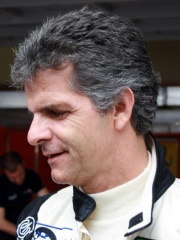
10. Chico Serra (b. 1957)
With an HPI of 59.11, Chico Serra is the 10th most famous Brazilian Racing Driver. His biography has been translated into 22 different languages.
Francisco Adolpho "Chico" Serra (born 3 February 1957) is a Brazilian racing driver.
People
Pantheon has 33 people classified as Brazilian racing drivers born between 1907 and 2004. Of these 33, 26 (78.79%) of them are still alive today. The most famous living Brazilian racing drivers include Nelson Piquet, Emerson Fittipaldi, and Rubens Barrichello. The most famous deceased Brazilian racing drivers include Ayrton Senna, Wilson Fittipaldi Júnior, and Carlos Pace. As of April 2024, 1 new Brazilian racing drivers have been added to Pantheon including Gabriel Bortoleto.
Living Brazilian Racing Drivers
Go to all RankingsNelson Piquet
1952 - Present
HPI: 74.83
Emerson Fittipaldi
1946 - Present
HPI: 74.29
Rubens Barrichello
1972 - Present
HPI: 67.51
Felipe Massa
1981 - Present
HPI: 62.63
Roberto Moreno
1959 - Present
HPI: 60.29
Bruno Senna
1983 - Present
HPI: 60.25
Chico Serra
1957 - Present
HPI: 59.11
Alex Ribeiro
1948 - Present
HPI: 56.42
Christian Fittipaldi
1971 - Present
HPI: 56.38
Maurício Gugelmin
1963 - Present
HPI: 54.58
Ingo Hoffmann
1953 - Present
HPI: 54.42
Ricardo Zonta
1976 - Present
HPI: 54.24
Deceased Brazilian Racing Drivers
Go to all RankingsAyrton Senna
1960 - 1994
HPI: 82.72
Wilson Fittipaldi Júnior
1943 - 2024
HPI: 65.73
Carlos Pace
1944 - 1977
HPI: 64.16
Luiz Bueno
1937 - 2011
HPI: 57.46
Chico Landi
1907 - 1989
HPI: 56.85
Fritz d'Orey
1938 - 2020
HPI: 54.59
Herbert MacKay-Fraser
1922 - 1957
HPI: 50.77
Newly Added Brazilian Racing Drivers (2025)
Go to all RankingsOverlapping Lives
Which Racing Drivers were alive at the same time? This visualization shows the lifespans of the 7 most globally memorable Racing Drivers since 1700.

